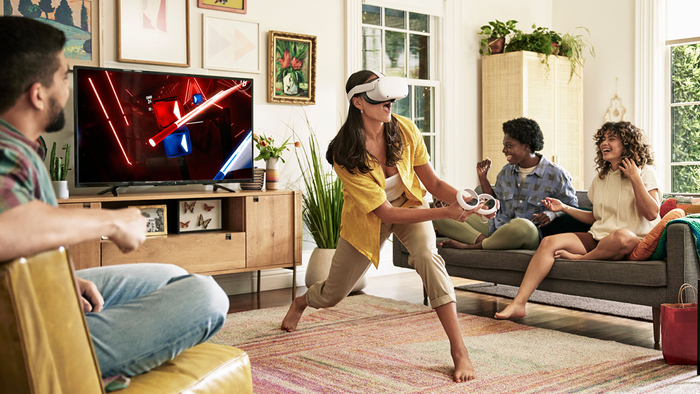
Featured Blog | This community-written post highlights the best of what the game industry has to offer. Read more like it on the Game Developer Blogs.
While video games are capable of achieving a progressive gender politic, this can only be achieved with a conscious acknowledgement of the tenets of gender criticism. Because we don't want more Dead or Alive Xtreme Beach Volley games, now do we.

By Kaitlin Tremblay
As much as we all love Dead or Alive Xtreme Beach Volleyball — wait, do we? — we have to admit it brings to light some pretty unsettling ideas about women and video games: namely, that representation of women has fought a long, hard (no pun intended, of course) fight to be more than characters with spectacular tits.
This isn’t to say that video games are evil and vehicles of patriarchy, because quite honestly, I think that video games, more than any other medium, are capable of achieving a thoughtful and progressive gender politic. It just needs to be conscious of gender criticism in order to do so, and to avoid the mentality of: “She has tits and she knows how to use a gun, what else do you want?” There has been resistance to approaches that criticize gender in games (albeit largely in comments threads), but I think that a lot of that resistance stems from a misunderstanding of what gender criticism is about. This article in an introduction to the major ideas that govern this mode of criticism, and how it applies to games.
How to Be: A Brief Introduction to Gender and Performance
Gender criticism is about identifying, exploring and bringing into focus stereotypical representations of gender. We challenge stereotypes of gender because ultimately, there is no innate, natural link between gender and sex, yet culture has imposed a hierarchy of roles based on these social, gendered constructs. Like the inevitable damsel in distress, Princess Peach. Peach, we all love you, but goddamn girl, get yourself some pepper spray.
In video games, the major stereotyped myths of women are typically the damsel in distress, hyper-sexualized villain (Sylvia Christel from No More Heroes) and the sexy/strong best friend (Tifa from Final Fantasy VII). Oh, and let’s not forget that pointy-haired Cloud has his eyes on the more feminine Aeris, so Tifa’s not even in the running as a viable love-interest because she wears drab clothing rather than a bright pink dress. In all of these instances, the female character is, more likely than not, in love with the male protagonist or trying desperately to bang him.
See the problem?
What we need to take away from gender criticism in order to appease us feminist-gamer-girls frothing at the mouths is that stereotypes are harmful and alienating. We need to understand what Judith Butler, one of the foremost gender critics of our time, means when she says that gender is a societal construct and is therefore being performed.
Performance theory is the conception that we have internalized or been socially conditioned into “becoming” our gender. or instance, femininity is performed (via our clothes, our posture, our attitude et cetera) the way an actor would perform a role: we are given a script and told to act. Except, unlike actors, we’re all exposed to the memory-erasing flash from Men In Black, and aren’t consciously aware that we are performing what it means to be feminine or what it means to be masculine; we assume that they are “natural.”
In saying that gender is a performance, I don’t mean that it’s not as simple as staring at your closet and deciding if you want to be feminine or masculine today; we don’t have an active choice about how our genders are performed. The signifiers of femininity (clothing, attitude, manner of speech and so forth) are all pre-scripted, and we receive the script from society and cultural indoctrination. This is why so many people cry out against stereotypical portrayals of gender, because this social conditioning on the performance of gender actually influences both the way an individual relates to themselves and the way society relates to them.
How to Play: Gender Possibilities in Games
Here’s where video games become brilliant. Especially in the light of such extreme character customization as with the Mass Effect franchise, we’re allowed to expose these traits, mix them up, pick and choose and perform however/whoever we want. Freed from societal concerns (and ultimately consequences, because gender performativity is reinforced through negative societal pressure), we can pick whatever traits/characteristics we want to play with. Not only do we get to choose if we want to be dude or not, we get to pick their attitude, their alignment, their history and proficiencies.
Video games are so much goddamn fun and can also offer the arena for the best — or worst — gender criticism. We need to remember that video games are one of the top forms of entertainment for children and therefore one of the most insistence avenues for receiving cultural information about ourselves. We need video games to be mindful of what they are teaching. This is part of why is it’s so much fun to play as Princess Peach in MarioKart: getting to throw a red shell at Bowser is cathartic as all hell, and it does a lot to disrupt the narrative of victim-hood that was so common in the games we played growing up.
The other major takeaway from Butler is that not only are these constructs, they are political constructs as well. Representation of gender is never neutral. The danger is that these stereotypes are vehicles for cultural conditioning of these societal constructs. And we need to keep this in mind for games that aren’t character customizable.
Here comes our second major issue identified by gender criticism: that is, the issue of representation and objectification. Let’s not forget that these stereotyped female characters are usually smoking hot. Which isn’t necessarily a problem, but tends to be. We’re drawn to beauty naturally, but the problem is that women tend to only serve the purpose of being beautiful and sexy, and this has always been a tool of suppression: “don’t you worry your pretty little head about this, this is a man’s problem.” When a women is primarily defined by her sexiness, then it’s as if that’s the only thing she can be.
Gods and Goddesses: Addressing Some Myths
I’d like to address this myth that sexualization in video games is necessarily bad – because it isn’t all the time. The trick is to sexualize, while at the same develop the character as a dynamic person, and not just a curvy woman who can only afford dominatrix clothing. Because let’s be honest: sexualisation and video games is never going to go away, for either gender. Nor should it. The characters we play become basically extensions of ourselves – and when I’m feeling sick and exhausted and don’t have the energy to change out of the same clothes I’ve worn for the past three days, it’s a pleasure to have my character to be sexy for me.
One argument offered against this criticism of women in games is that men, especially in RPGs, are just as sexualized as women. While this is true, the difference tends to be that when men are sexy, there tends to be more to them. While I cited Sylvia Christel earlier as an example of the hyper-sexualized villain, I want to add a caveat: I also would say she has a fair amount of characterization added to her, especially in No More Heroes 2. She becomes more than just the hot bitch pulling the strings.
But when women are just sexualized and offer nothing else to the story arc, we run into the issue of objectification. Mary Ann Doane, using theories developed by Laura Mulvey, tackles female spectatorship in regards to film, but her theory is helpful here, because she states that cinema (essentially a spectator art) evicts the female spectator by virtue of creating her as the object of desire for the male gaze, despite the fact that the video game is creating a narrative about females. The problem is that if females are presented as only objects for sexual consumption, a large portion of women are left alienated by this — and the ones that aren’t, are forced into the same spectatorial role as men. All the while, this eviction is creating a narrative about women, that is predicated on their exclusion.
The point here is that we need to make this theory of spectatorship obsolete: there has to be a way for gamer girls to identify with video games without being either the sex -kitten or aligned with masculinity.
Here’s where things get touchy: in video games, male characters are also sexualized and depicted with extreme machismo and presented as ideals (Mario notwithstanding). But that isn’t all they are. They’re dynamic. And when we play games that offer only male characters as the lead, we’re all aligning ourselves with that character. In feminist criticism, the masculine subject is often regarded as “the universal,” relegating female characters to the position of “other” – they’re something other than the standard, active subject.
The issue with gender criticism in video games is that female characters have had a hell of a time escaping this othered position. And it’s a crime, because the gaming industry and nerd culture has faced it’s own share of being “othered” within society. While this stereotyping of gender within video games is definitely shifting, it is always imperative to be conscious of what is being said about gender through the representations and narrativization of all characters involved. And we can’t stop interrogating these stereotypes and gendered roles, because the only way to achieve subversion is through constant questioning and revitalizing of our concepts of gender.
This leads me to a final myth I’d like to address: that men won’t enjoy playing as a female character. According to this, women identify easier with male characters, than men do with female characters. If this is the case, then it’s only because men are conditioned to be aversive to identifying with femininity (and the violence and cultural bias against drag queens illustrates this). Back to Doanne and Mulvey: if a female spectator is going to identify with anybody, it has to be with the male spectator because there is no such thing as the female spectator, because females are only ever objects to be looked at. Why else all the super sexy, yet weather-inappropriate outfits female characters don?
The difference is that in video games, it is not mere spectatorship. We become the protagonist, and thus are necessarily in an active position. Video games become a way of bridging the distance between what we see and what this image culturally represents. Resident Evil: Code Veronica serves as an example of how gender does not change the game play of video games. The game play is divided between Claire and Chris Redfield. And while Claire does get saved by Steve, who professes his love for her as he dies, this doesn’t change the fact that the immediate connection made with the game is through her: you won’t make it to the Chris part, unless you succeed as Claire. You become either character fluidly and enjoy the game on the exact same level.
While video games have fallen victim to the same cultural traps in their gender politics, they also serve as a venue for an incredible amount of subversion and change. But in order to achieve this subversion of stereotypical gender norms, we need to be consciously aware and constantly challenging the images, representations and characterizations that are handed to us.
Read more about:
Featured BlogsAbout the Author(s)
You May Also Like







